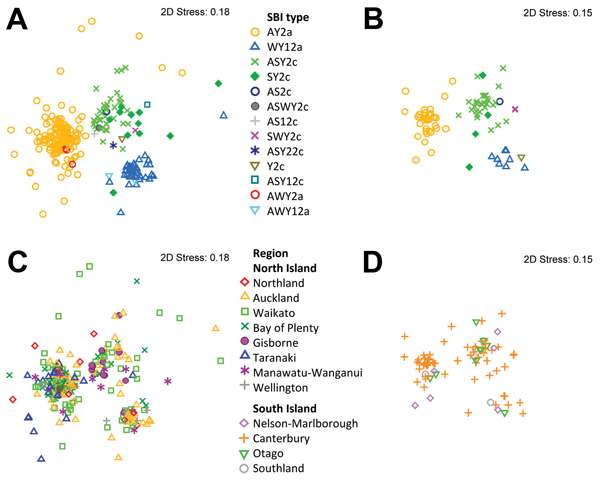Geographic Divergence of Bovine and Human Shiga Toxin–Producing Escherichia coli O157:H7 Genotypes, New Zealand1
Patricia Jaros

, Adrian L. Cookson, Donald M. Campbell, Gail E. Duncan, Deborah Prattley, Philip E. Carter, Thomas E. Besser, Smriti Shringi, Steve Hathaway, Jonathan C. Marshall, and Nigel P. French
Author affiliations: Massey University, Palmerston North, New Zealand (P. Jaros, D. Prattley, J.C. Marshall, N.P. French); AgResearch Ltd, Palmerston North (A.L. Cookson); Ministry for Primary Industries, Wellington, New Zealand (D.M. Campbell, G.E. Duncan, S. Hathaway); Institute of Environmental Science and Research Ltd, Porirua, New Zealand (P. Carter); Washington State University, Pullman, Washington, USA (T.E. Besser, S. Shringi)
Main Article
Figure 3

Figure 3. Multidimensional scaling plots showing the genotypic clustering of human Shiga toxin–producing Escherichia coli O157:H7 isolates originating from the North Island (n = 274, 4 isolates excluded) and the South Island (n = 81, 4 isolates excluded), New Zealand. The plots were determined on the basis of the isolates’ pulsed-field gel electrophoresis profiles. Clusters associated with Shiga toxin–encoding bacteriophage insertion (SBI) types (A) and regions (C) for isolates from the North Island. Clusters associated with SBI types (B) and regions (D) for isolates from the South Island. 2D, 2 dimensional.
Main Article
Page created: November 18, 2014
Page updated: November 18, 2014
Page reviewed: November 18, 2014
The conclusions, findings, and opinions expressed by authors contributing to this journal do not necessarily reflect the official position of the U.S. Department of Health and Human Services, the Public Health Service, the Centers for Disease Control and Prevention, or the authors' affiliated institutions. Use of trade names is for identification only and does not imply endorsement by any of the groups named above.
